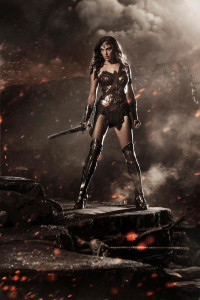I love high heels.
I love wearing them to work, feeling tall and powerful. I love towering over my male friends. I love stomping and strutting and feeling like a superhero with just a few extra inches.
I love how I look and feel in high heels.
So why do female nerds have such an issue with high heels? Back in July, the first promotional image of Wonder Woman’s cinematic costume was released to outcries of sexism. The costume was dissected bit by bit, but the biggest issue, it seems, was the fact that Wondey was wearing heels.
The same outcry was heard when DC released the Selena Kyle poster for the Dark Knight Rises, which featured Catwoman’s knife-sharp stilettos destroying a batarang. There was also outrage about Zero Suit Samus, already a fairly sexualized version of everybody’s favorite metal plated space warrior, because Nintendo had slapped some very high heels on her in the latest Super Smash Brothers game.
This is a topic that geeky women (and nerds in general) are constantly discussing. Heels are often vilified, and for good reason. Many geeks assert that high heels imply the character is being designed explicitly for the male view. While heels do create a physically attractive and powerful visual impact, they also provide a block for female characters. It’s hard to move in some heels, stability and balance are often forsaken for pretty looking feet, and running is almost completely out of the question. The implication is that women in heels are not as capable to be physical as men.
However, it has also been posited that critiquing high heels (and boob windows and short skirts) ultimately amounts to slut shaming. But when you look at the mediums being discussed, they are primarily fictional. Characters are just that, characters. It’s one thing to criticize an actual human being for how they dress, there is legitimacy in calling that slut shaming, but characters are created specifically to find an audience and encourage them to buy merchandise. They have no personal will or agency, and they are explicitly created for an agenda (which is usually, simply, to make money).
The male gaze often does factor in to the creation of characters, as in popular nerdy mediums men tend to be the people writing, drawing, and creating the content (at least initially). However, the most important thing about these characters is the fact that who they are is ultimately up to the interpretation of the individual consuming the media. I can interpret Power Girl as a powerful, second wave feminist icon because, from her origin, she was written as unashamed of her gender and her body, but did not feel the need to use her sexuality as a weapon. Someone else can just as easily interpret her as a prime example of how male writers ham-fistedly explain sexist costume choices. Neither opinion is wrong, and this allows fans to engage in a complex discourse about how characters can be viewed.
Before my interview with Ellie Pyle at New York Comic Con, she commented that she constantly argues with a fellow Marvel editor about heroines in high heels. Ellie told me, and I’m inclined to agree, ‘if she can fly, it would be easy for her to move around in high heels.’ I don’t see any issue with characters wearing high heels if it makes sense to their personality as written.
If I were a superhero, I would absolutely wear heels (especially if I could fly). To be fair, I type this while wearing 4 inch heels.
If nothing else, heels can be used to justify the power of a female character. After all, Gingers Rogers did everything Fred Astaire did, but backwards in high heels. Maybe the same can be said for Wonder Woman and Superman.





